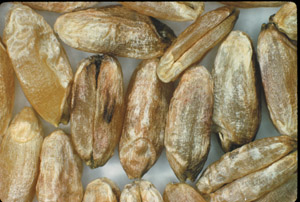
Features
Bioenergy
Ethanol
Enzymes lower costs for cellulosic ethanol
Transgenics fuel enzymatic process in the kernel.
February 16, 2008 By Ralph Pearce
Efforts to streamline and improve the cost efficiency process of cellulosic ethanol have been slow recently, which has become a point of frustration for those trying to bring it to market. It is widely held that cellulosic ethanol is preferred over the current conventional route which relies predominantly on the starch of a corn kernel. Find the key that unlocks a cost efficient process for breaking down and fermenting the glucose polymers contained in cellulose, and facilities across North America would have an endless supply of feedstocks; including switchgrass, wheat or rice straw and sawdust.
 |
| The technology Dr. Elizabeth Hood is working on will implant the valuable enzymes needed to unlock the key to cellulosic ethanol within the kernel, not the stalks and leaves. |
Dr. Elizabeth Hood believes she has found the key and once this development becomes commercially available, the ethanol value chain will have some significant modifications to consider. Hood is the current associate vice chancellor for research and technology transfer at Arkansas State University in Jonesboro and chief executive officer of Infinite Enzymes, a biotech firm that produces enzymes for industrial applications. During the past five years, Hood has been part of a team of researchers working to develop an enzyme that will efficiently produce cellulosic ethanol from corn plants as well as other forms of biomass.
The essential stage in the production of cellulosic ethanol is breaking down the long polymer chains containing glucose molecules. The challenge in the case of cellulose is that these molecules are crystalline in structure, making it difficult to degrade. “Over the years, fungal and bacterial organisms have developed the enzyme systems to degrade those chains, and a few plant genes can do it, but not very many,” says Hood. The fungal and bacterial enzymes can be cloned, however, and the genes implanted into other plants with the purpose of digesting materials down into sugars so yeast can ferment them. “When you’re talking about cellulosic ethanol, you always have to add the enzymes to digest the material down into single sugars, so what we’re doing is producing them in transgenic plants instead of in fungal cultures.”
What the team has found is that it is capable of producing two enzymes: endocellulase and exocellulase. One cuts the middle of a cellulose microfibril and the other ‘chews’ it from the end, together producing sugars. The result is astounding. Hood and her team of researchers have been able to impart the enzyme into a corn kernel instead of the leaves or the stalks, as is being researched by other companies. If all goes well, she believes growers could see this developed for commercial
availability within the next four years.
“We can make enough enzyme in one kernel to digest 20 or 30 corn plants, including the stalks and leaves,” details Hood, adding that the enzymes are produced in the embryo rather than the endosperm, where all the starch is located. “So we’re making a concentrated source of enzymes, produced in the seed, so it’s stored and can be added to any substrate.”
Opens opportunities in many fields
One of the larger criticisms about conventional corn-based ethanol is the recent ‘food for fuel’ controversy, where the price of corn has driven the market to demand more corn to feed the ethanol industry and a US government mandated biofuel concentration. When Hood and researchers finalize this
enzymatic process, cellulosic ethanol will provide more fuel and take less corn to produce it.
 |
| Current models from Infinite Enzymes suggest half of corn stover could be removed without affecting soil health. |
“We can show how just planting more acres of this transgenic corn crop will allow us to produce the volumes that are necessary to fulfill the industry,” she says, referring to US President George W. Bush’s goal to have 35 billion gallons of ethanol produced by 2017 (with the passage of the US Energy Bill on December 18, 2007, that figure was altered to 36 billion by 2020). “To reach that, we have to have 50 million dry tons of cellulosic material per year, digested. With that comes the need for tonnes of cellulase enzyme, so in order to meet those criteria, we either have to produce it in our system, which means planting more acres of our corn line, or building more fermenters to produce it by fungal fermentation. With our system, we don’t have to build any fermenters.”
Based on a US model, Hood takes the process a few steps further, noting that a co-op with 100,000 acres of corn being grown for an ethanol facility would incorporate dry milling to separate high quality starch from the germ. “The starch would then go to the ethanol facility, and I would buy the germ which would have my enzyme as well as some oil,” explains Hood. “Then we could press the oil and sell it as a co-product, and then take the defatted\germ as our enzyme-containing source that would then go to make ethanol from cellulose.”
According to her calculations, the cost of using current technology to derive the necessary enzymes to get to an E10 ethanol society in the US would be about US$10 billion to build capital infrastructure. Yet the cellulosic technology that she and her team have developed is considerably less, since it only requires the planting of more corn acres with no capital investments other than farm equipment. With Hood’s system, the starch as well as the germ can be utilized, creating valuable co-products.
“When you use corn, you’re using the starch fraction and starch is treated very differently than cellulose,” she says. “But once you make sugars, you have the same technology to ferment it into ethanol in the same still. The end product in both cases is glucose, and the glucose is then fermented into alcohol. It’s just a different polymer but is embedded in a very complex matrix, and that’s why it’s taking longer to develop the cellulosic ethanol industry.” -end-